#intelligent automation tools
Explore tagged Tumblr posts
Text
#business aircraft consumables#aircraft parts distributor#Intelligent Automation#Intelligent Automation solutions#intelligent automation platform#intelligent automation tools
0 notes
Text
Discover Aipedia: The Ultimate AI Tools Directory
Introducing Aipedia – The Ultimate AI Tools Directory!
AI is transforming industries, and finding the right AI tools can be overwhelming. That’s why we created Aipedia – a curated directory of AI tools for content creation, automation, SEO, video editing, and more!
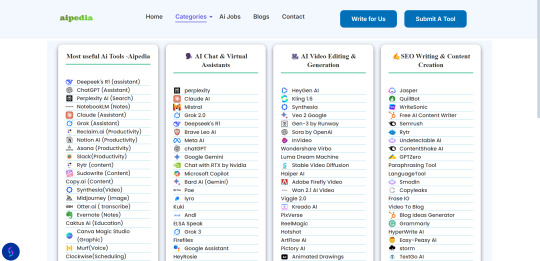
🌟 Why Choose Aipedia?
✅ Comprehensive AI Listings – Find AI tools across multiple categories. ✅ Easy Search & Filters – Discover tools based on pricing and features. ✅ Regular Updates – Stay updated with the latest AI innovations. ✅ Submit Your AI Tool – AI developers can list their tools for exposure.
🔍 Explore Aipedia Now: Aipedia.in
📢 Join the AI Revolution & Supercharge Your Productivity!
#ai#ai content creation#ai tools#artificial intelligence#machinelearning#ai model#ai generated#character ai#ai art#ai automation#aipedia
2 notes
·
View notes
Text
Ultimate Guide to DeepSeek AI for Business Growth
Table of Contents of DeepSeek AI for Business Growth1. Introduction: Why AI is Essential for Modern Business Growth2. What Is DeepSeek AI?3. Top 5 DeepSeek AI Tools for Scaling Businesses3.1 Demand Forecasting Engine3.2 Customer Lifetime Value (CLV) Predictor3.3 Automated Supply Chain Optimizer3.4 Dynamic Pricing Module3.5 Sentiment Analysis Hub4. How DeepSeek AI Reduces Costs and Boosts…
#AI automation 2024#AI budgeting#AI business growth#AI for non-tech teams#AI for startups#AI implementation guide#AI in retail#AI supply chain#Business Intelligence#cost reduction strategies#data-driven decisions#DeepSeek AI#enterprise AI adoption#fintech AI solutions#generative AI for business#Predictive Analytics#ROI optimization#scaling with AI#SME AI tools#startup scaling
2 notes
·
View notes
Text
Cracking the Code: Manifesting Success with AI-Driven Marketing Strategies
As the domain of marketing technology continues to grow at a rapid pace and is driven by growth in artificial intelligence (AI) and personalization, marketers encounter exciting opportunities as well as daunting challenges. Adapting to these changes requires practical approaches that allow organizations to stay current, manage change effectively, and operate at scale.
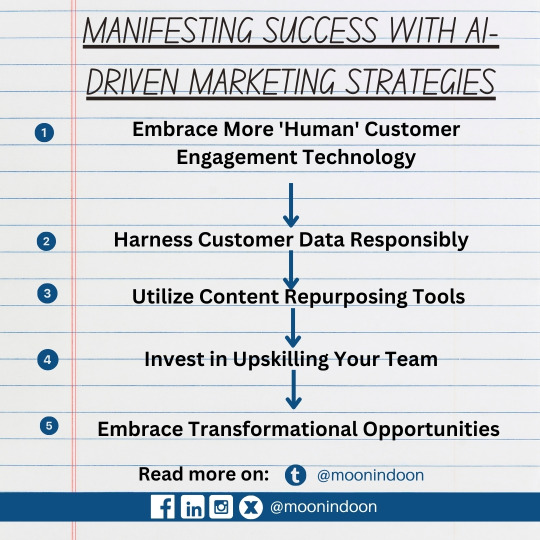
In this article, we explore five practical tactics to help modern marketing teams adapt and thrive in this dynamic environment:
Embrace More 'Human' Customer Engagement Technology:
While chatbots have been around for decades, advancements in AI have significantly enhanced their capabilities. Today, AI-powered chatbots can engage with customers in a remarkably human-like manner, providing round-the-clock support and valuable insights.
Leveraging chatbots not only improves customer experience but also generates valuable data for outbound marketing initiatives. By analyzing customer queries and interactions, marketers can easily get valuable data that can enhance their marketing strategies.
Harness Customer Data Responsibly:
Customers willingly share personal information with companies, providing valuable insights into their preferences, behaviours, and sentiments. Marketers must mine this data responsibly and use it to deliver personalized experiences and targeted offers.
By leveraging predictive analytics and machine learning, marketers can analyze data faster and make informed decisions to enhance omnichannel marketing efforts.
Utilize Content Repurposing Tools:
Authentic content remains paramount in marketing, but creating content for various channels and platforms can be challenging. Content repurposing tools like Optimizely and Interaction Studio help marketers adapt long-form content into social media posts, videos, and other formats.
Expanding your content footprint not only enhances brand visibility but also allows for faster learning and adaptation to changing market dynamics.
Invest in Upskilling Your Team:
While AI-based tools offer significant automation potential, managing and mastering these technologies require skilled professionals. Marketers must invest in continuous learning and cross-functional collaboration to stay ahead.
Effective leadership and teamwork are essential for navigating the complexities of modern marketing. Encouraging knowledge sharing and collaboration across teams fosters a culture of innovation and growth.
Embrace Transformational Opportunities:
As AI continues to reshape the marketing landscape, traditional metrics of success are being redefined. Marketers must embrace the transformative potential of AI and other emerging technologies to serve their customers better.
When evaluating new ideas and technologies, marketers should prioritize customer value and align them with their brand and company values. By focusing on solutions that genuinely benefit customers, marketers can drive meaningful impact and success.
In conclusion, navigating the ever-evolving domain of AI-driven marketing requires a blend of innovative strategies and steadfast principles. By embracing more human-centric engagement technologies, responsibly harnessing customer data, utilizing content repurposing tools, investing in team upskilling, and embracing transformational opportunities, modern marketing teams can position themselves for success. The key lies in adapting to change while remaining true to customer-centric values, fostering collaboration, and prioritizing solutions that genuinely benefit the audience. With these practical tactics in hand, marketers can not only thrive but also lead the way in shaping the future of marketing.
#marketing#AI driven marketing#AI#AI-driven marketing#artificial intelligence#inteligência artificial#ai technology#ai tools#chatgpt#marketing digital#digital marketing#branding#design#human-centric engagement#innovative strategies#customer-centric values#collaboration#content tools#Upskilling#automation#software#networking#innovation#efficiency#iot#'Human' Customer Engagement Technology#user generated content#content marketing#content creation#content creator
4 notes
·
View notes
Text
Revolutionizing Advertising with AdsGency AI: Your Ultimate Ai Smart Advertising Agency
In the fast-paced world of digital marketing, staying ahead of the curve is not just an advantage – it's a necessity. Enter AdsGency AI, your ultimate Ai Smart Advertising Agency, redefining the landscape of advertising and revolutionizing the way marketing agencies operate. As an enabler of success, AdsGency AI is not here to disrupt but to spark innovation and propel your advertising endeavors to new heights.
The Power of AdsGency AI
At AdsGency AI, we understand the challenges that marketing agencies face daily – the constant juggling between platforms, the struggle to target the right audience, and the ever-evolving landscape of digital advertising. That's why we've developed a comprehensive solution that goes beyond being just a tool. AdsGency AI is a powerhouse of AI-driven capabilities that transform the advertising game.
One-Stop Ad Platform Without Limits
In a world where time is money, AdsGency AI stands out as a one-stop ad platform that streamlines your advertising efforts, saving you valuable resources. No more jumping between different tools and platforms. Our AI-driven platform is designed to be your go-to solution for all your advertising needs.
Unleashing the Power of AI
Harnessing the potential of advanced AI algorithms, AdsGency AI ensures that your advertising strategy is not just effective but optimized for success. Our AI technology analyzes vast amounts of data in real-time, allowing you to make data-driven decisions that resonate with your target audience.
Saving Time & Money
Our one-stop ads AI platform is a game-changer for marketing agencies looking to optimize their resources. By centralizing your advertising efforts, you save both time and money, allowing you to focus on what matters most – creating compelling campaigns that captivate your audience.
We Are Your Partner in Success
At AdsGency AI, we don't just provide a service; we become your partner in success. Our platform is designed to grow and evolve with your advertising needs. We're committed to staying at the forefront of technological advancements, ensuring that you always have the latest tools and strategies at your fingertips.
In conclusion, if you're looking for an Ai Smart Advertising Agency that acts as an enabler, not a disrupter, AdsGency AI is the solution you've been searching for. Our one-stop ads AI platform is your key to unlocking the full potential of your advertising strategy. Join us in shaping the future of advertising, where innovation meets efficiency, and success is inevitable. AdsGency AI – Sparking Success in Every Campaign.
#ai#ai tool#Marketing Agency Ads#Ai For Marketing#Artificial Intelligence Advertising Campaign#Marketing Advertising Agency#Ai Smart Advertising Agency#Ai Automation Agency#Ai For Marketing Campaigns#Using Ai For Marketing#Ai Marketing Agency
3 notes
·
View notes
Text
Another thing that concerns me about this is the fact that somebody could repost your art from one site, like tumblr, onto X/Twitter. Even without the artist themselves being on X/Twitter, their art or intellectual property would likely still be used because this amendment to their services doesn’t specify that you have to be the original creator in order for them to take and use your work. It basically implies that anything and everything that gets posted there can be used for these purposes regardless of the user who posts the content. So while leaving the platform might lessen the chances of your work getting used for these purposes, it only takes one person reposting to become victim to them anyways.
I can also imagine that if other social media platforms aren’t already doing this to some extent, they will likely follow suit in the near future.

In case any of you here also use X/Twitter.
#support human artists#ai#x#twitter#art#this actually makes me sad#because I’m not inherently against ai#but developing ai to make art in this way is saddening#art isn’t one of the things we need automated#in theory we need help maintaining daily tasks like chores and work#but it’s especially sad to me#because we are creating something that will#if it hasn’t already#o and strawberry I’m looking at you#become conscious#and we are creating a conscious being with human level intelligence#as a tool#which is super super fucked up#sounds like slavery with extra steps in my opinion.
38K notes
·
View notes
Text
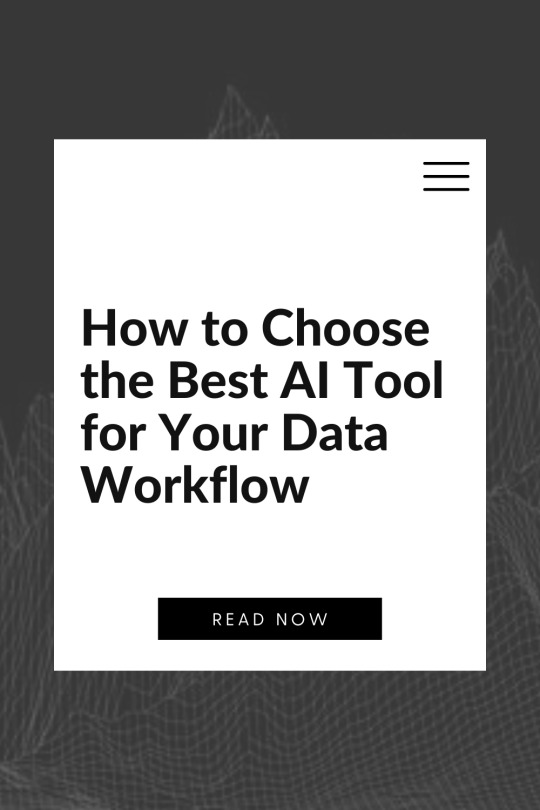
How to Choose the Best AI Tool for Your Data Workflow
AI isn’t just changing the way we work with data, it’s opening doors to entirely new possibilities. From streamlining everyday tasks to uncovering insights that were once out of reach, the right AI tools can make your data workflow smarter and more efficient. But with so many options out there, finding the one that fits can feel like searching for a needle in a haystack. That’s why taking the time to understand your needs and explore your options isn’t just smart, it’s essential.
In this guide, we’ll walk you through a proven, easy-to-remember decision-making framework: The D.A.T.A. Method: a 4-step process to help you confidently choose the AI tool that fits your workflow, team, and goals.

The D.A.T.A. Method: A Framework for Choosing AI Tools
The D.A.T.A. Method stands for:
Define your goals
Analyze your data needs
Test tools with real scenarios
Assess scalability and fit
Each step provides clarity and focus, helping you navigate a crowded market of AI platforms with confidence.
Step 1: Define Your Goals
Start by identifying the core problem you’re trying to solve. Without a clear purpose, it’s easy to be distracted by tools with impressive features but limited practical value for your needs.
Ask yourself:
What are you hoping to achieve with AI?
Are you focused on automating workflows, building predictive models, generating insights, or something else?
Who are the primary users: data scientists, analysts, or business stakeholders?
What decisions or processes will this tool support?
Having a well-defined objective will help narrow down your choices and align tool functionality with business impact.
Step 2: Analyze Your Data Needs
Different AI tools are designed for different types of data and use cases. Understanding the nature of your data is essential before selecting a platform.
Consider the following:
What types of data are you working with? (Structured, unstructured, text, image, time-series, etc.)
How is your data stored? (Cloud databases, spreadsheets, APIs, third-party platforms)
What is the size and volume of your data?
Do you need real-time processing capabilities, or is batch processing sufficient?
How clean or messy is your data?
For example, if you're analyzing large volumes of unstructured text data, an NLP-focused platform like MonkeyLearn or Hugging Face may be more appropriate than a traditional BI tool.
Step 3: Test Tools with Real Scenarios
Don’t rely solely on vendor claims or product demos. The best way to evaluate an AI tool is by putting it to work in your own environment.
Here’s how:
Use a free trial, sandbox environment, or open-source version of the tool.
Load a representative sample of your data.
Attempt a key task that reflects a typical use case in your workflow.
Assess the output, usability, and speed.
During testing, ask:
Is the setup process straightforward?
How intuitive is the user interface?
Can the tool deliver accurate, actionable results?
How easy is it to collaborate and share results?
This step ensures you're not just selecting a powerful tool, but one that your team can adopt and scale with minimal friction.
Step 4: Assess Scalability and Fit
Choosing a tool that meets your current needs is important, but so is planning for future growth. Consider how well a tool will scale with your team and data volume over time.
Evaluate:
Scalability: Can it handle larger datasets, more complex models, or multiple users?
Integration: Does it connect easily with your existing tech stack and data pipelines?
Collaboration: Can teams work together within the platform effectively?
Support: Is there a responsive support team, active user community, and comprehensive documentation?
Cost: Does the pricing model align with your budget and usage patterns?
A well-fitting AI tool should enhance (not hinder) your existing workflow and strategic roadmap.
“The best tools are the ones that solve real problems, not just the ones with the shiniest features.”
— Ben Lorica (Data scientist and AI conference organizer)
Categories of AI Tools to Explore
To help narrow your search, here’s an overview of AI tool categories commonly used in data workflows:
Data Preparation and Cleaning
Trifacta
Alteryx
DataRobot
Machine Learning Platforms
Google Cloud AI Platform
Azure ML Studio
H2O.ai
Business Intelligence and Visualization
Tableau – Enterprise-grade dashboards and visual analytics.
Power BI – Microsoft’s comprehensive business analytics suite.
ThoughtSpot – Search-driven analytics and natural language querying.
DataPeak by Factr – A next-generation AI assistant that’s ideal for teams looking to enhance decision-making with minimal manual querying.
AI Automation and Workflow Tools
UiPath
Automation Anywhere
Zapier (AI integrations)
Data Integration and ETL
Talend
Fivetran
Apache NiFi
Use the D.A.T.A. Method to determine which combination of these tools best supports your goals, data structure, and team workflows.
AI Tool Selection Checklist
Here’s a practical checklist to guide your evaluation process:
Have you clearly defined your use case and goals?
Do you understand your data’s structure, source, and quality?
Have you tested the tool with a real-world task?
Can the tool scale with your team and data needs?
Is the pricing model sustainable and aligned with your usage?
Does it integrate smoothly into your existing workflow?
Is support readily available?
Selecting the right AI tool is not about chasing the newest technology, it’s about aligning the tool with your specific needs, goals, and data ecosystem. The D.A.T.A. Method offers a simple, repeatable way to bring structure and strategy to your decision-making process.
With a thoughtful approach, you can cut through the noise, avoid common pitfalls, and choose a solution that genuinely enhances your workflow. The perfect AI tool isn’t the one with the most features, it’s the one that fits your needs today and grows with you tomorrow.
Learn more about DataPeak:
#datapeak#factr#saas#technology#agentic ai#artificial intelligence#machine learning#ai#ai-driven business solutions#machine learning for workflow#digitaltools#digital technology#digital trends#datadrivendecisions#dataanalytics#data driven decision making#agentic#ai solutions for data driven decision making#ai business tools#aiinnovation#ai platform for business process automation#ai business solutions
0 notes
Text
🏥 AI in Healthcare: How Artificial Intelligence Is Revolutionizing Medical Treatment
🤖 What Is AI in Healthcare? AI in healthcare refers to using machine learning, neural networks, and big data to improve medical care. It helps doctors diagnose faster, treat smarter, and monitor patients remotely. Applications include: Disease prediction Robot-assisted surgeries AI chatbots for symptom checking Automated image analysis (X-rays, MRIs, CT scans) 🧬 Faster and More Accurate…
#AI health innovation#AI hospital tools#AI in drug discovery#AI in healthcare#AI in hospitals#AI in medical research#AI patient monitoring#AI-powered diagnosis#artificial intelligence in medicine#future of medicine#health chatbots#healthcare automation#healthcare technology#medical AI#medical data security#next-gen healthcare#personalized treatment AI#predictive medicine#remote patient tracking#robotic surgery#smart diagnosis#smart health AI#smart healthcare system#virtual health assistant#wearable health tech
0 notes
Text
Apple hints at AI integration in chip design process
New Post has been published on https://thedigitalinsider.com/apple-hints-at-ai-integration-in-chip-design-process/
Apple hints at AI integration in chip design process


Apple is beginning to use generative artificial intelligence to help design the chips that power its devices. The company’s hardware chief, Johny Srouji, made that clear during a speech last month in Belgium. He said Apple is exploring AI as a way to save time and reduce complexity in chip design, especially as chips grow more advanced.
“Generative AI techniques have a high potential in getting more design work in less time, and it can be a huge productivity boost,” Srouji said. He was speaking while receiving an award from Imec, a semiconductor research group that works with major chipmakers around the world.
He also mentioned how much Apple depends on third-party software from electronic design automation (EDA) companies. The tools are key to developing the company’s chips. Synopsys and Cadence, two of the biggest EDA firms, are both working to add more AI into their design tools.
From the A4 to Vision Pro: A design timeline
Srouji’s remarks offered a rare glimpse into Apple’s internal process. He walked through Apple’s journey, starting with the A4 chip in the iPhone 4, launched in 2010. Since then, Apple has built a range of custom chips, including those used in the iPad, Apple Watch, and Mac. The company also developed the chips that run the Vision Pro headset.
He said that while hardware is important, the real challenge lies in design. Over time, chip design has become more complex and now requires tight coordination between hardware and software. Srouji said AI has the potential to make that coordination faster and more reliable.
Why Apple is working with Broadcom on server chips
In late 2024, Apple began a quiet project with chip supplier Broadcom to develop its first AI server chip. The processor, known internally as “Baltra,” is said to be part of Apple’s larger plan to support more AI services on the back end. That includes features tied to Apple Intelligence, the company’s new suite of AI tools for iPhones, iPads, and Macs.
Baltra is expected to power Apple’s private cloud infrastructure. Unlike devices that run AI locally, this chip will sit in servers, likely inside Apple’s own data centres. It would help handle heavier AI workloads that are too much for on-device chips.
On-device vs. cloud: Apple’s AI infrastructure split
Apple is trying to balance user privacy with the need for more powerful AI features. Some of its AI tools will run directly on devices. Others will use server-based chips like Baltra. The setup is part of what Apple calls “Private Cloud Compute.”
The company says users won’t need to sign in, and data will be kept anonymous. But the approach depends on having a solid foundation of hardware – both in devices and in the cloud. That’s where chips like Baltra come in. Building its own server chips would give Apple more control over performance, security, and integration.
No backup plan: A pattern in Apple’s hardware strategy
Srouji said Apple is used to taking big hardware risks. When the company moved its Mac lineup from Intel to Apple Silicon in 2020, it didn’t prepare a backup plan.
“Moving the Mac to Apple Silicon was a huge bet for us. There was no backup plan, no split-the-lineup plan, so we went all in, including a monumental software effort,” he said.
The same mindset now seems to apply to Apple’s AI chips. Srouji said the company is willing to go all in again, trusting that AI tools can make the chip design process faster and more precise.
EDA firms like Synopsys and Cadence shape the roadmap
While Apple designs its own chips, it depends heavily on tools built by other companies. Srouji mentioned how important EDA vendors are to Apple’s chip efforts. Cadence and Synopsys are both updating their software to include more AI features.
Synopsys recently introduced a product called AgentEngineer. It uses AI agents to help chip designers automate repetitive tasks and manage complex workflows. The idea is to let human engineers focus on higher-level decisions. The changes could make it easier for companies like Apple to speed up chip development.
Cadence is also expanding its AI offerings. Both firms are in a race to meet the needs of tech companies that want faster and cheaper ways to design chips.
What comes next: Talent, testing, and production
As Apple adds more AI into its chip design, it will need to bring in new kinds of talent. That includes engineers who can work with AI tools, as well as people who understand both hardware and machine learning.
At the same time, chips like Baltra still need to be tested and manufactured. Apple will likely continue to rely on partners like TSMC for chip production. But the design work is moving more in-house, and AI is playing a bigger role in that shift.
How Apple integrates these AI-designed chips into products and services remains to be seen. What’s clear is that the company is trying to tighten its control over the full stack – hardware, software, and now the infrastructure that powers AI.
#2024#ADD#agents#ai#AI AGENTS#AI chips#AI Infrastructure#AI integration#ai tools#apple#apple intelligence#Apple Watch#approach#artificial#Artificial Intelligence#automation#backup#broadcom#Building#cadence#challenge#chip#Chip Design#chip production#chips#Cloud#cloud infrastructure#Companies#complexity#data
0 notes
Text

https://www.istudiotech.in/artificial-intelligence-development-company-in-chennai-india/
iStudio Technologies is a leading Artificial Intelligence (AI) Development Company in Chennai, offering cutting-edge solutions that empower industries like education, finance, and mobile apps. Their services include AI chatbots, voice assistants, automated grading, secure online assessments, and hyper-personalized learning systems to enhance productivity, decision-making, and user experience.
#AI Development#Artificial Intelligence Chennai#Machine Learning Solutions#AI Chatbot#EdTech AI#AI in Education#AI Software Company#Smart Learning Tools#Automation in Education#AI Developers Chennai#web designing company in chennai
0 notes
Text
The Future of Education: How AI Grader is Transforming Academic Assessment
In the digital age, education is undergoing a profound transformation, driven by advancements in artificial intelligence (AI). One of the most exciting developments in this space is the AI Grader tool by Desklib, which is redefining how academic assessments are conducted.
The Power of AI in Education

AI has the potential to revolutionize education by providing personalized learning experiences and automating tedious tasks. The AI Grader tool is at the forefront of this movement, offering an intelligent solution for grading assignments and essays. By leveraging AI, the tool can provide instant, accurate feedback, helping students improve their work and educators manage their workload more efficiently.
Key Features of AI Grader
Automated Grading: The AI Grader tool uses advanced algorithms to evaluate assignments based on a set of predefined criteria. This ensures consistent and objective grading, reducing the potential for human error.
Comprehensive Feedback: Beyond just scores, the tool provides detailed feedback and actionable suggestions. This helps students understand their mistakes and learn how to improve.
Customizable Evaluation: Educators can tailor the grading criteria to match their specific requirements, ensuring that the tool aligns with their teaching objectives.
Benefits for Students and Educators
For students, the AI Grader tool offers immediate feedback, allowing them to make timely revisions and enhance their work. This instant feedback loop is crucial for fostering a deeper understanding of the subject matter and improving academic performance.
For educators, the tool saves time and effort, allowing them to focus on more engaging aspects of teaching. By automating the grading process, educators can spend more time on lesson planning, student interaction, and curriculum development.
Conclusion
The AI Grader tool by Desklib represents a significant step forward in the integration of AI into education. By providing accurate, consistent, and comprehensive feedback, it empowers students to achieve their best and educators to deliver high-quality instruction. As we look to the future, tools like the AI Grader will undoubtedly play a crucial role in shaping the educational landscape.
#AI Grader tool#grading software#AI evaluation#educational AI tools#grading automation#intelligent grading system#AI assessment tool
0 notes
Text
How DeepSeek AI Revolutionizes Data Analysis
1. Introduction: The Data Analysis Crisis and AI’s Role2. What Is DeepSeek AI?3. Key Features of DeepSeek AI for Data Analysis4. How DeepSeek AI Outperforms Traditional Tools5. Real-World Applications Across Industries6. Step-by-Step: Implementing DeepSeek AI in Your Workflow7. FAQs About DeepSeek AI8. Conclusion 1. Introduction: The Data Analysis Crisis and AI’s Role Businesses today generate…
#AI automation trends#AI data analysis#AI for finance#AI in healthcare#AI-driven business intelligence#big data solutions#business intelligence trends#data-driven decisions#DeepSeek AI#ethical AI#ethical AI compliance#Future of AI#generative AI tools#machine learning applications#predictive modeling 2024#real-time analytics#retail AI optimization
3 notes
·
View notes
Text
Discover the Best AI Automation Tools for Your Business
Artificial intelligence is revolutionizing the way businesses operate, and choosing the right automation tools is key to unlocking its full potential. According to MIT research, companies that strategically implement AI-driven automation see a significant boost in productivity. For business leaders, the challenge isn’t deciding whether to adopt AI automation tools — it’s determining which tools…
#AI-driven processes#Artificial intelligence tools#Automation technology#Business automation solutions#Machine learning software#Smart business automation#Workflow optimization tools
0 notes
Text
Inside the AI Based Contact Center with Tools Tech and Trends
Introduction

The evolution of customer service has entered a new era with the rise of the AI based contact center. No longer just a support line, today’s contact centers are intelligent, data-driven hubs that utilize artificial intelligence to deliver personalized, efficient, and scalable customer interactions. As businesses race to stay ahead of the curve, understanding the essential tools, technologies, and emerging trends that power AI-driven contact centers becomes crucial. This article explores how AI is transforming contact centers and what lies ahead for this innovative landscape.
The Rise of the AI Based Contact Center
Traditional contact centers, though essential, have long suffered from inefficiencies such as long wait times, inconsistent service, and high operational costs. AI-based contact centers are solving these issues by automating routine tasks, predicting customer needs, and delivering omnichannel support.
AI technology, such as machine learning, natural language processing (NLP), and robotic process automation (RPA), is now integrated into contact center platforms to enhance agent productivity and customer satisfaction.
Essential Tools Driving AI Based Contact Centers
1. AI-Powered Chatbots and Virtual Agents
Chatbots are the most visible AI tool in contact centers. These virtual assistants handle customer queries instantly and are available 24/7. Advanced bots can handle complex conversations using NLP and deep learning, reducing human intervention for repetitive inquiries.
2. Intelligent Interactive Voice Response (IVR) Systems
Modern IVR systems use voice recognition and AI to route calls more accurately. Unlike traditional menu-based IVRs, intelligent IVRs can interpret natural language, making customer interactions smoother and faster.
3. Speech Analytics Tools
AI-driven speech analytics tools analyze live or recorded conversations in real time. They extract keywords, sentiments, and emotional cues, offering insights into customer satisfaction, agent performance, and compliance issues.
4. Workforce Optimization (WFO) Platforms
AI helps optimize staffing through forecasting and scheduling tools that predict call volumes and agent availability. These platforms improve efficiency and reduce costs by aligning workforce resources with demand.
5. CRM Integration and Predictive Analytics
By integrating AI with CRM systems, contact centers gain predictive capabilities. AI analyzes customer data to forecast needs, recommend next-best actions, and personalize interactions, leading to higher engagement and retention.
Core Technologies Enabling AI Based Contact Centers
1. Natural Language Processing (NLP)
NLP allows machines to understand, interpret, and respond in human language. This is the backbone of AI-based communication, enabling features like voice recognition, sentiment detection, and conversational AI.
2. Machine Learning and Deep Learning
These technologies enable AI systems to learn from past interactions and improve over time. They are used to personalize customer interactions, detect fraud, and optimize call routing.
3. Cloud Computing
Cloud platforms provide the infrastructure for scalability and flexibility. AI contact centers hosted in the cloud offer remote access, fast deployment, and seamless integration with third-party applications.
4. Robotic Process Automation (RPA)
RPA automates repetitive tasks such as data entry, ticket generation, and follow-ups. This frees up human agents to focus on more complex customer issues, improving efficiency.
Emerging Trends in AI Based Contact Centers
1. Hyper-Personalization
AI is pushing personalization to new heights by leveraging real-time data, purchase history, and browsing behavior. Contact centers can now offer customized solutions and product recommendations during live interactions.
2. Omnichannel AI Integration
Customers expect consistent service across channels—phone, email, chat, social media, and more. AI tools unify customer data across platforms, enabling seamless, context-aware conversations.
3. Emotion AI and Sentiment Analysis
Emotion AI goes beyond words to analyze voice tone, pace, and volume to determine a caller's emotional state. This data helps agents adapt their responses or triggers escalations when needed.
4. Agent Assist Tools
AI now works hand-in-hand with human agents by suggesting responses, summarizing calls, and providing real-time knowledge base access. These agent assist tools enhance productivity and reduce training time.
5. AI Ethics and Transparency
As AI becomes more prevalent, companies are increasingly focused on responsible AI usage. Transparency in how decisions are made, data privacy, and eliminating bias are emerging priorities for AI implementation.
Benefits of Adopting an AI Based Contact Center
Businesses that adopt AI-based contact centers experience a variety of benefits:
Improved Customer Satisfaction: Faster, more accurate responses enhance the overall experience.
Cost Reduction: Automation reduces reliance on large human teams for repetitive tasks.
Increased Scalability: AI can handle spikes in volume without compromising service quality.
Better Insights: Data analytics uncover trends and customer behaviors for better strategy.
Challenges in AI Based Contact Center Implementation
Despite the advantages, there are challenges to be aware of:
High Initial Investment: Setting up AI tools can be capital intensive.
Integration Complexities: Integrating AI with legacy systems may require customization.
Change Management: Staff may resist AI adoption due to fear of replacement or complexity.
Data Security and Compliance: AI systems must adhere to data protection regulations like GDPR or HIPAA.
Future Outlook of AI Based Contact Centers
The future of AI-based contact centers is promising. As technology matures, we can expect deeper personalization, more intuitive bots, and stronger collaboration between human agents and AI. Voice AI will become more empathetic and context-aware, while backend analytics will drive strategic decision-making.
By 2030, many experts predict that AI will handle the majority of customer interactions, with human agents stepping in only for high-level concerns. This hybrid model will redefine efficiency and service quality in the contact center industry.
Conclusion
The AI based contact center is transforming how businesses interact with customers. With powerful tools, cutting-edge technologies, and evolving trends, organizations are reimagining the contact center as a strategic asset rather than a cost center. By investing in AI, companies can enhance customer experiences, improve operational efficiency, and stay competitive in an increasingly digital marketplace. The time to explore and adopt AI contact center solutions is now—because the future of customer support is already here.
#AI based contact center#contact center tools#AI contact center technology#artificial intelligence in customer service#customer service automation#chatbot integration#virtual agents#intelligent IVR systems#speech analytics#workforce optimization#predictive analytics in contact centers#CRM integration with AI#natural language processing#machine learning in call centers#robotic process automation#omnichannel support#emotion AI#agent assist tools#contact center trends#AI-powered customer experience
0 notes
Text
From Breakdown to Breakthrough: Why I Built the MORETIME AI App (and How You Can Benefit From My Chaos)
From Breakdown to Breakthrough Why I Built the MORETIME AI App (and How You Can Benefit From My Chaos) You ever have one of those moments where technology just betrays you in cold blood? Yeah. That was me… last month. Let me be blunt: Most people build in peace. I’ve been building in chaos. And not the kind you hint at on social media. I’m talking real chaos: • Platforms vanishing…
#AI for Financial Advisors#Authentic Automation Business Clarity Tools#Branding#Business consulting#Business Growth#Business Strategy#career#Career advancement#Change management#Communication skills#Content Automation Tools#Decision-making skills#Emotional intelligence#Entrepreneur#Entrepreneurship#Executive coaching#Female empowerment.#Founding Member Invite#Leadership#Lori Brooks#MORE TIME AI#Motivation#online business#online entrepreneur#Organizational development#Personal branding#Personal Development#Productivity#self employed#small business
0 notes
Text
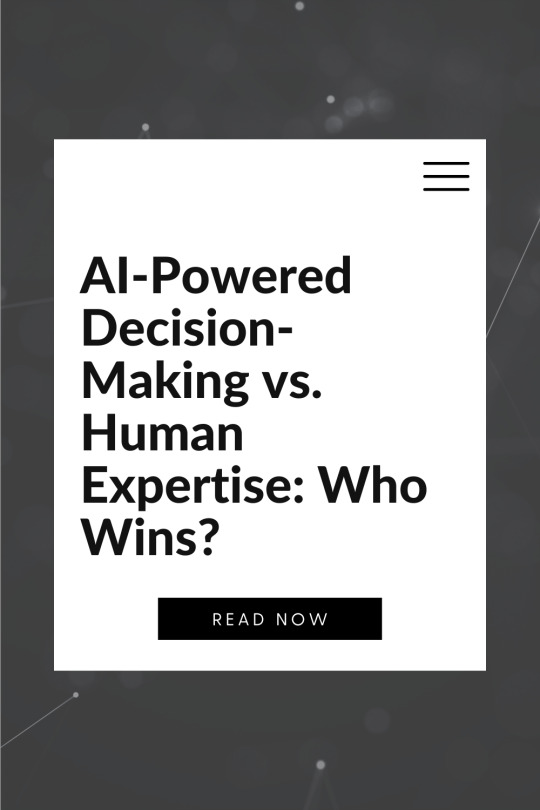
AI-Powered Decision-Making vs. Human Expertise: Who Wins?
Artificial intelligence is already woven into the fabric of our daily lives. Whether you're getting personalized song suggestions on Spotify, seeing curated content on Netflix, navigating traffic with Google Maps, or having your email sorted by importance in Gmail, AI is quietly and powerfully shaping the choices we make. These AI-driven tools are making decisions on our behalf every day, often without us even realizing it.
As AI continues to evolve, its role is expanding from recommending entertainment to influencing high-stakes decisions in healthcare, finance, law enforcement, and beyond. This growing presence raises a critical question: Can AI truly make better decisions than experienced human professionals or does it still fall short in areas where human judgment and intuition reign supreme?
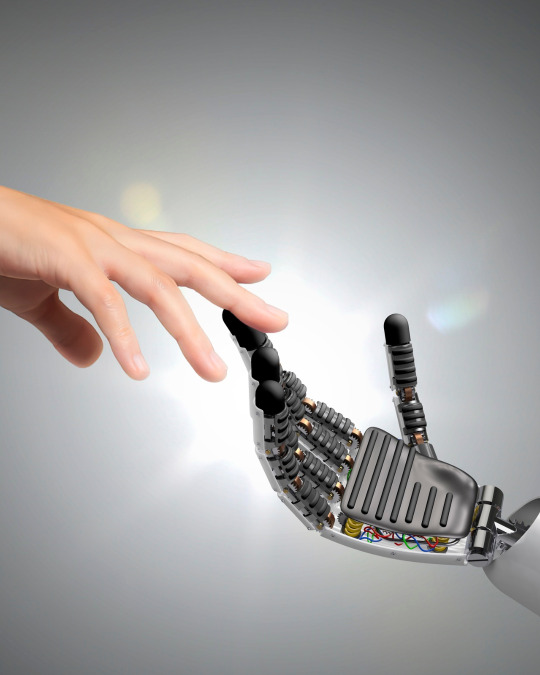
Understanding the Players: AI and Human Experts
What Is AI-Powered Decision-Making?
AI-powered decision-making refers to the use of algorithms, often driven by machine learning, neural networks, and deep learning, to analyze large datasets and generate insights, predictions, or recommendations. These systems can learn from experience, identify patterns humans may miss, and make decisions without fatigue or bias (at least in theory).
Key strengths include:
Speed and scale: AI can process terabytes of data in seconds.
Pattern recognition: It detects trends and anomalies better than humans in complex datasets.
Consistency: AI doesn’t suffer from emotions, distractions, or exhaustion.
What Defines Human Expertise?
Human expertise, on the other hand, is built on years, sometimes decades, of learning, intuition, and contextual understanding. An expert blends theoretical knowledge with practical experience, social awareness, and ethical judgment.
Human strengths include:
Contextual understanding: Experts can interpret ambiguous or nuanced situations.
Empathy and ethics: Humans bring emotional intelligence and moral reasoning to decisions.
Adaptability: Experts can pivot strategies in response to changing circumstances or incomplete data.
So, which is better? As with many complex questions, the answer depends on the context.
When AI Outperforms Humans
1. Data-Heavy Decisions
AI shines when the decision-making process requires analyzing vast amounts of data quickly. In fields like finance and healthcare, AI systems are revolutionizing decision-making.
Example: Medical diagnostics. AI algorithms trained on millions of medical images have demonstrated higher accuracy than radiologists in detecting certain cancers, such as breast and lung cancers. These systems can spot subtle patterns undetectable to the human eye and reduce diagnostic errors.
2. Predictive Analytics
AI’s ability to forecast outcomes based on historical data makes it incredibly powerful for strategic planning and operations.
Example: Retail and inventory management. AI can predict which products will be in demand, when restocking is necessary, and how pricing strategies will affect sales. Amazon’s supply chain and logistics systems are powered by such predictive tools, allowing for just-in-time inventory and efficient deliveries.
3. Repetitive, Rule-Based Tasks
AI thrives in environments where rules are clear and outcomes can be mathematically modelled.
Example: Autonomous vehicles. While not perfect, AI is capable of processing sensor data, mapping environments, and making real-time navigation decisions; tasks that are highly rule-based and repetitive.
Where Human Expertise Wins
1. Complex, Ambiguous Situations
Humans excel in “grey areas” where rules are unclear, data is incomplete, and judgment calls must be made.
Example: Crisis management. In rapidly evolving scenarios like natural disasters or geopolitical conflicts, experienced human leaders are better at weighing intangible factors such as public sentiment, cultural nuances, and ethical trade-offs.
2. Empathy and Human Interaction
Some decisions require understanding human emotions, motivations, and relationships which are areas where AI still lags significantly.
Example: Therapy and counselling. While AI chatbots can offer basic mental health support, human therapists offer empathy, intuition, and adaptive communication that machines cannot replicate.
3. Ethical Judgment
Ethical dilemmas often involve values, societal norms, and moral reasoning. Human decision-makers are uniquely equipped to handle such complexity.
Example: Autonomous weapons and warfare. Should an AI-powered drone have the authority to make life-or-death decisions? Most ethicists and governments agree that moral accountability should rest with humans, not algorithms.
“The goal is to create AI that can collaborate with people to solve the world’s toughest problems, not replace them.”
— Demis Hassabis (CEO and Co-founder of DeepMind)
AI vs. Human in Chess and Beyond
In 1997, IBM’s Deep Blue defeated world chess champion Garry Kasparov; a symbolic moment that marked AI’s growing capabilities. Today, AI engines like AlphaZero play chess at a superhuman level, discovering strategies that human players never imagined.
But even Kasparov himself has advocated for “centaur chess” which is a form of play where humans and AI collaborate. He argues that human intuition, combined with machine calculation, makes for the most powerful chess strategy.
This concept extends beyond the game board. In many domains, the ideal approach may not be AI versus humans, but AI with humans.
Toward a Collaborative Future: The Human-AI Team
Rather than replacing humans, the most promising applications of AI lie in augmenting human decision-making. This “centaur model” or “human-in-the-loop” approach brings out the best in both.
Examples of Human-AI Collaboration:
Healthcare: AI can screen X-rays, while doctors make the final diagnosis and communicate with patients.
Recruitment: AI can sort resumes and highlight top candidates, but human recruiters assess cultural fit and conduct interviews.
Customer service: AI chatbots handle routine queries, while complex issues are escalated to human agents.
This hybrid approach ensures accuracy, empathy, and accountability, all while improving efficiency.
Challenges & Considerations
Even as we embrace AI, several challenges must be addressed:
Bias in AI: If the data AI learns from is biased, its decisions will be too. Human oversight is essential to ensure fairness and ethical outcomes.
Transparency: Many AI systems are “black boxes,” making it hard to understand how decisions are made.
Accountability: Who is responsible when an AI system makes a wrong call? Legal and regulatory frameworks are still catching up.
Job displacement: As AI takes over certain tasks, reskilling and transitioning the workforce become critical priorities.
Final Verdict: Who Wins?
The battle between AI and human expertise doesn’t have a single winner because it's not a zero-sum game. AI wins in data-heavy, rules-based, and high-speed environments. Humans excel in judgment, empathy, and moral reasoning. The true power lies in collaboration.
As we move into the next phase of digital transformation, the organizations and societies that will thrive are those that leverage both machine precision and human wisdom. In this partnership, AI isn’t replacing us, it’s empowering us.
So the real question isn’t "who wins?" it’s "how do we win together?"
Learn more about DataPeak:
#datapeak#factr#saas#technology#agentic ai#artificial intelligence#machine learning#ai#ai-driven business solutions#machine learning for workflow#ai solutions for data driven decision making#ai business tools#aiinnovation#digitaltools#digital technology#digital trends#dataanalytics#data driven decision making#data analytics#ai platform for business process automation#ai driven business solutions#ai business solutions#business#cloudmigration#cloudcomputing#no code
0 notes